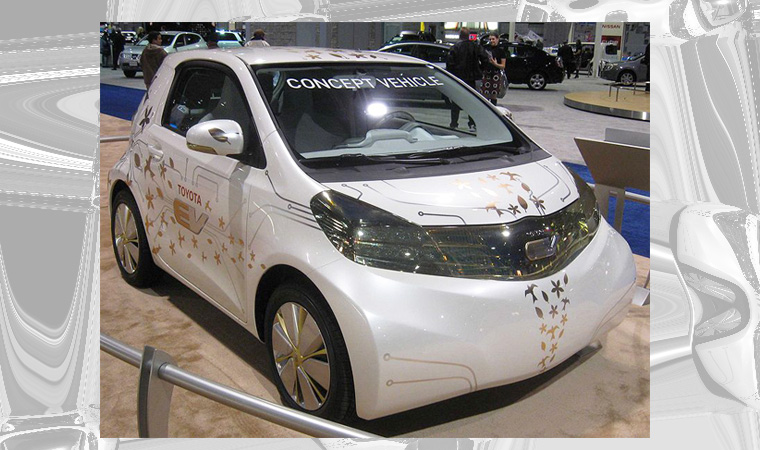

Toyota iQ Part2
Concept cars
FT-EV concept
The Toyota FT-EV concept was unveiled at the January 2009 North American International Auto Show.
It is a battery electric concept vehicle with an estimated capacity of 50 miles (80 km). Toyota plans to launch the production version of FT-EV in 2012.
A slightly modified version was shown as the FT-EV II at the October 2009 Tokyo Motor Show.
iQ Customize Car (2009–)
This is a family of Toyota iQ custom body kits in Japanese market.
MODELLISTA MAXI includes custom front bumper, side skirt, rear bumper. MODELLISTA MIXTURE includes custom B-pillar shadow, mirror cover, back window panel, side door trim. MODELLISTA MIXTURE side make set only includes custom mirror cover and side door trim.
Toyota iQ "GAZOO Racing tuned by MN" (130G, 2009–)
This is a limited (100 units) version for Japanese market. It included 1,329 cubic centimetres (1.329 L; 81.1 cu in) I4 engine, 6-speed manual transmission, stiffer sport suspension that lowers its ride height by 30 mm (1.2 in), rear disk brakes, RAYS 16x5.5-in aluminium wheels with 175/60R16 tires, enhanced brakes, stiffening brace, tachometer, aluminium pedals, rear spoiler, GRMN emblem, sport exhaust system.
The GAZOO Racing package adds a front bumper spoiler, side mudguards, rear bumper spoiler centre muffler, Toyota front fog lamps, original decal, front sport seat covers. The vehicle was unveiled at the January 2009 Tokyo Auto Salon.
The GAZOO Racing cars were sold through Toyota's Netz dealer channel.[20] It has MSRP of ¥1,972,000 (¥1,878,095+tax).
iQ for Sports/iQ Collection (2009)
These are show cars that demonstrate possibilities for customers to personalise their cars. iQ for Sports reflects modern urban chic through a purpose-made body kit emphasizing the iQ's broad stance, powerful geometry and clean sweeping lines. iQ Collection focuses on interior customisation.
The vehicles were unveiled at the 2009 Frankfurt Motor Show.
Scion iQ
The Scion iQ Concept car was built by Five Axis (California, USA) based on the Toyota iQ and displayed in April 2009 at the New York Auto Show. It is based on the production Toyota iQ, has a four cylinder engine, 18" wheels and widened wheel arches.[23] The production Scion iQ was revealed at the 2010 New York Auto Show. It is now currently for sale throughout the United States.
GRMN iQ Racing Concept (2011)
The GRMN iQ Racing Concept was based on Toyota iQ "GAZOO Racing tuned by MN" car sold in 2009, but with a super charger and roll cage.
The vehicle was unveiled in 2011 Tokyo Auto Salon.[25]
GRMN iQ Supercharger (2012)
It is a limited (100 units) version of Toyota iQ for Japanese market, based on the Toyota iQ 130G MT. It included the supercharger found in the GRMN iQ Racing Concept car. The prototype vehicle was unveiled in 2012 Tokyo Auto Salon.
Scion iQ EV
A prototype of the Toyota iQ EV (Scion iQ EV in the US) was exhibited at the 2011 Geneva Motor Show. The Scion iQ EV is the successor to the FT-EV II as an electric vehicle based on the Toyota iQ chassis.[27][28] Toyota produced three generations of FT-EV concept cars, and the iQ EV is a production version of those concepts, incorporating the technological and design strengths of all three models. The exterior of the production version is based on the FT-EV III concept shown at the 2011 Tokyo Motor Show.[29]
The U.S. launch of the Scion iQ EV was announced for 2012,[30][31] and according to Toyota, for the initial roll-out the iQ EV would not be available to individual consumers, instead the carmaker decided to focus on fleet customers and car sharing programs.[32] The iQ EV was scheduled to be produced at Toyota’s Takaoka Plant in Toyota City beginning in August 2012 and the initial production was planned to be limited to 600 units, with 400 staying in Japan, 100 units destined to the U.S. and the other 100 for Europe.[33] In September 2012 Toyota announced that due to customers' concerns about range and charging time, the production of the Scion iQ (Toyota eQ in Japan) will be limited to 100 units for special fleet use in Japan and the U.S. only, of which, 90 will be placed in American carsharing demonstration projects.[5][6] The iQ EV will be priced in the Japanese market at ¥3.6 million (~US$$45,000). The iQ EV/eQ was scheduled to be released in both countries in December 2012.[5]
The first 30 units were delivered in the U.S. to the University of California, Irvine in March 2013 for use in its Zero Emission Vehicle-Network Enabled Transport (ZEV-NET) carsharing fleet. Since 2002 the ZEV-NET program has been serving the transport needs of the Irvine community with all-electric vehicles for the critical last mile of commutes from the Irvine train station to the UC campus and local business offices.[6]
Specifications
Designed as a city commuting vehicle, the iQ EV has a lower battery capacity that also translates into a shorter charging time, allowing the car to be fully recharged in approximately three hours, and using fast charging, the battery can be recharged up to 80% capacity in only 15 minutes. The iQ EV has a 150 cell 12 kWh 277.5 V lithium-ion battery pack that delivers a NEDC-certified range of 85 km (53 mi),[29] and rated 80 km (50 mi) in the U.S.[6] Based on further development of Toyota's Hybrid Synergy Drive technology, the iQ EV's fully electric powertrain comprises an air-cooled, 47 kW electric motor/generator, the 12 kWh battery pack, a 3 kW water-cooled battery charger, an inverter, an DC/DC converter and a motor speed reduction mechanism. Maximum torque of 163 Nm is delivered to the front wheels, giving the iQ EV 0-100 km/h acceleration of 14.0 seconds and a maximum speed of 125 km/h (78 mph). As all Toyota's full hybrid vehicles, the iQ EV is equipped with a regenerative braking system.[29]
The iQ EV has a minimum turning radius of just 4.1 m (13 ft) and with a length of 3,120 mm (123 in), making the iQ EV just 135 mm (5.3 in) longer than a standard iQ. The electric car shares the iQ overall width of 1,680 mm (66 in), height of 1,505 mm (59.3 in) and wheelbase of 2,000 mm (79 in). High tensile sheet steel has been extensively used in the body shell construction to minimize the additional weight caused by the lithium-ion battery pack, and as a result, the iQ EV weighs just 125 kg (280 lb) more than a standard 1.3L CVT iQ.[29]
Fuel economy
The U. S. Environmental Protection Agency rated the 2013 iQ EV with a combined fuel economy of 121 miles per gallon gasoline equivalent (MPG-e) (1.9 L/100 km) with an energy consumption of 28 kW-hrs/100 miles. The city rating is 138 MPG-e (1.7 L/100 km) with an energy consumption of 24 kW-hrs/100 miles and 105 MPG-e (2.2 L/100 km) with an energy consumption of 32 kW-hrs/100 miles for highway driving.[34] As of December 2012, these ratings allow the 2013 iQ EV to be the most fuel efficient EPA-certified vehicle of all fuel types considered in all years,[35] and the iQ EV was also ranked first in DOE-EPA's 2013 Annual Fuel Economy Guide.
Aston Martin Cygnet
The Aston Martin Cygnet is a 3-door hatchback marketed by Aston Martin beginning with model year 2011 as a rebadged variant of the Toyota iQ. The Cygnet enables Aston Martin to comply with the European Union–imposed fleet average emissions regulations taking effect in 2012.
The Cygnet was initially only sold in the UK. Production and sales commenced in January 2011 and the market coverage was expanded to cover other European countries the following year.[39] Sales will not be restricted; however, it is expected that demand from existing Aston Martin owners for Cygnet would initially take priority. Aston CEO Ulrich Bez recently announced shipping expectations of about 4000 per year at a price of about £30,000[40] – about three times as much as the iQ.[41] Bez claims that the Cygnet demonstrates the company's "commitment to innovation and integrity", whilst respecting the need to "satisfy demands of emissions and space".[42]
Aston Martin's changes to the design were to exterior tweaks and a reworked interior. One of the first Cygnets to arrive in the UK was sold at the Aston Martin dealership in Welwyn Garden City, and had a full, professionally photographed detail/valet to promote the car.[43]
The Cygnet has a 97 bhp (72 kW; 98 PS) 1.3L straight-4 engine,[44] it produces 110 g of CO2/km and the fuel consumption is 58.9 mpg-US (3.99 L/100 km; 70.7 mpg-imp).[45]







